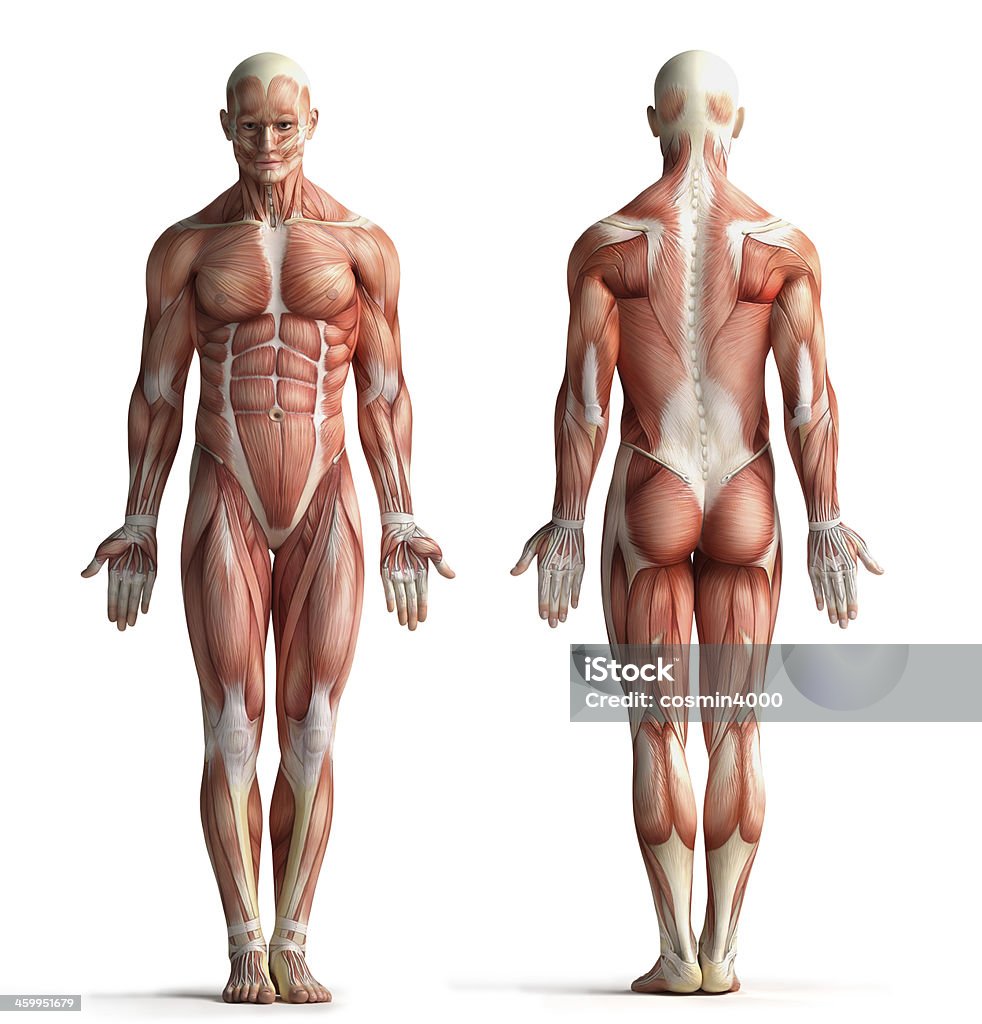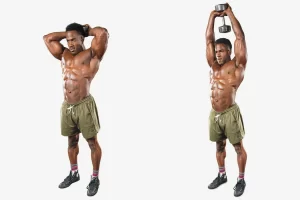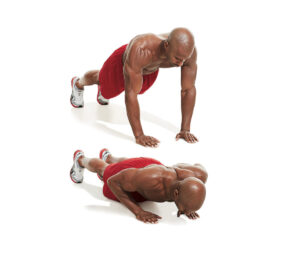
Handsome Muscular Men Exercise at the Gym
Introduction
If you are here today, it is probably because you are a bodybuilder, a health enthusiast, or someone who is interested in reading about Muscle Anatomy: What Bodybuilders Need to Know before Lifting Weights. In this informative article, we will walk together through the nitty-gritty of muscle anatomy. We will find out why you need to understand muscle anatomy before lifting weights, and how this information can help you be a better bodybuilder
Understanding muscle anatomy is crucial for bodybuilders because it allows them to optimise their training routines, achieve balanced muscle development, prevent injuries, and enhance overall performance. By knowing the specific muscles being targeted during exercises and the proper way to target these muscles of interest safely, bodybuilders can tailor their workouts to effectively stimulate growth in desired areas with no injury. Additionally, understanding muscle anatomy helps in identifying weaknesses or imbalances, enabling targeted training strategies to achieve symmetrical and proportionate muscle development. This knowledge also aids in injury prevention by ensuring proper form and technique, thereby promoting long-term health and sustainability in bodybuilding pursuits. Ultimately, a thorough grasp of muscle anatomy empowers bodybuilders to make informed decisions about their training, leading to more efficient progress towards their fitness goals.

How the knowledge of bodybuilding can enhance bodybuilders’ training effectiveness and safety
Knowledge of muscle anatomy enhances training effectiveness and safety in several key ways. Some of these key ways are explained below:
- Targeted Muscle Activation: Understanding which muscles are involved in each exercise allows bodybuilders to focus on proper muscle activation. This ensures that the intended muscles are being worked effectively, leading to better gains in strength and size.
- Form and Technique: Knowing muscle anatomy helps bodybuilders maintain proper form and technique during exercises. This reduces the risk of injury by ensuring that joints are stabilized correctly and muscles are engaged optimally.
- Avoiding Overtraining: Bodybuilders can design balanced workout routines by targeting all major muscle groups equally. This prevents overtraining specific muscles and reduces the risk of strains or imbalances that could lead to injuries, distorted or irregular shape over time.
- Identifying Weaknesses: Awareness of muscle anatomy allows bodybuilders to identify weak areas or muscle imbalances. They can then incorporate targeted exercises to strengthen these areas, promoting overall symmetry and reducing the risk of compensatory injuries.
- Choosing Effective Exercises: Knowledge of muscle anatomy helps in selecting exercises that effectively target desired muscle groups. Bodybuilders can prioritize compound movements for overall muscle development and isolation exercises to target specific areas, ensuring a well-rounded training regimen.
- Rehabilitation and Recovery: In case of injuries, understanding muscle anatomy aids in planning rehabilitation exercises that safely strengthen and restore affected muscles. This promotes faster recovery and minimizes the chances of reoccurrence of injury.
Overall, a thorough understanding of muscle anatomy empowers bodybuilders to train more effectively by maximizing muscle activation, optimizing workout routines, and minimizing the risk of injuries, thereby supporting long-term progress and success in their fitness goals.
Basic muscle anatomy

Basic muscle anatomy involves understanding the structure and function of muscles within the human body. Here are the key components:
- Muscle Fibers: Muscles are composed of thousands of muscle fibers, which are long, cylindrical cells capable of contracting and relaxing. These fibers are grouped together into bundles called fascicles.
- Fascicles: Fascicles are bundles of muscle fibers surrounded by connective tissue called perimysium. The arrangement of fascicles within a muscle determines its shape and function.
- Muscle Belly: The main body, or belly, of a muscle is the fleshy part that contracts when the muscle is activated. It is composed of multiple fascicles and is responsible for generating force.
- Tendons: Tendons are tough, fibrous connective tissues that attach muscles to bones. They transmit the force generated by muscle contractions to move bones and joints.
- Muscle Origin and Insertion: Every muscle has an origin and an insertion point. The origin is the fixed attachment point of the muscle to a bone, usually more proximal (closer to the body’s center). The insertion is the movable attachment point, typically more distal (further away from the body’s center). When a muscle contracts, it pulls on the insertion, causing movement at the joint.
- Muscle Function: Muscles can contract and relax to produce movement and stabilize joints. They work in antagonistic pairs (e.g., biceps and triceps) to move bones and maintain posture.
- Types of Muscles: Muscles are categorized into three types based on their structure and function:
- Skeletal Muscles: These are attached to bones and responsible for voluntary movements such as walking or lifting weights.
- Smooth Muscles: Found in the walls of hollow organs (e.g., intestines, blood vessels) and responsible for involuntary movements.
- Cardiac Muscle: Found in the heart and responsible for pumping blood throughout the body.
Understanding these basic aspects of muscle anatomy provides a foundation for bodybuilders to effectively target and train specific muscles, optimize workout routines, prevent injuries, and achieve balanced muscle development. It also facilitates communication with fitness professionals and healthcare providers regarding training strategies and rehabilitation plans.

Types of Muscle Fibers
Muscle fibers are categorized into two main types: slow-twitch (Type I) and fast-twitch (Type II), each with distinct characteristics and roles in training for bodybuilders:
- Slow-Twitch (Type I) Muscle Fibers:
- Characteristics: Slow-twitch fibers are characterized by their endurance and resistance to fatigue. They have a high concentration of mitochondria (which produce energy aerobically) and myoglobin (which stores oxygen), giving them a red color.
- Function: These fibers are primarily involved in sustained, low-intensity activities such as endurance exercises (e.g., long-distance running, cycling) or activities requiring prolonged muscle contractions (e.g., maintaining posture).
- Training Implications: Bodybuilders can benefit from training slow-twitch fibers to enhance endurance and improve muscle stamina. Higher repetitions (12-20+) with lighter weights stimulate slow-twitch fibers, promoting muscular endurance and metabolic adaptations such as increased capillary density and mitochondrial biogenesis.
- Fast-Twitch (Type II) Muscle Fibers:
- Characteristics: Fast-twitch fibers are optimized for rapid force generation and are more susceptible to fatigue. They can be further subdivided into Type IIa (fast oxidative glycolytic) and Type IIx (fast glycolytic) fibers.
- Type IIa fibers have moderate resistance to fatigue and utilize both aerobic and anaerobic metabolism.
- Type IIx fibers are highly powerful but fatigue quickly, relying primarily on anaerobic metabolism.
- Function: Fast-twitch fibers are recruited for explosive movements and activities requiring short bursts of power, such as sprinting, jumping, and lifting heavy weights.
- Training Implications: Bodybuilders aim to target fast-twitch fibers to increase muscle size (hypertrophy) and strength. This is achieved through high-intensity, low-repetition exercises (e.g., 4-8 repetitions) with heavy weights. Such training stimulates muscle fiber recruitment and promotes adaptations such as increased muscle cross-sectional area and improved neuromuscular efficiency.
- Characteristics: Fast-twitch fibers are optimized for rapid force generation and are more susceptible to fatigue. They can be further subdivided into Type IIa (fast oxidative glycolytic) and Type IIx (fast glycolytic) fibers.
Training Strategy for Bodybuilders:
- Balanced Approach: Effective training for bodybuilders involves targeting both slow-twitch and fast-twitch muscle fibers to achieve overall muscular development and performance.
- Periodization: Incorporating training phases that emphasize endurance (higher reps, lighter weights) and strength (lower reps, heavier weights) can optimize muscle fiber adaptation and prevent plateauing.
- Individual Variation: Understanding individual muscle fiber composition can help bodybuilders tailor their training programs to capitalize on their genetic strengths and weaknesses.
By understanding the characteristics and training implications of slow-twitch and fast-twitch muscle fibers, bodybuilders can design more effective workout routines that support their goals of muscle hypertrophy, strength development, endurance, and overall performance improvement.
Muscle groups relevant to bodybuilding
In bodybuilding, the major muscle groups are targeted to achieve balanced muscle development and overall physique enhancement. Here’s an outline of the key muscle groups that bodybuilders typically focus on:
- Chest Muscles:
- Primary Muscles: Pectoralis major (upper, middle, and lower portions).
- Secondary Muscles: Anterior deltoids (front shoulder), triceps.
- Back Muscles:
- Primary Muscles: Latissimus dorsi (lats), trapezius (traps), rhomboids.
- Secondary Muscles: Posterior deltoids (rear shoulder), biceps.
- Leg Muscles:
- Quadriceps (Quads): Rectus femoris, vastus lateralis, vastus medialis, vastus intermedius.
- Hamstrings: Biceps femoris, semitendinosus, semimembranosus.
- Calves: Gastrocnemius, soleus.
- Shoulder Muscles:
- Deltoid Muscles: Anterior deltoid (front), lateral deltoid (side), posterior deltoid (rear).
- Rotator Cuff: Supraspinatus, infraspinatus, teres minor, subscapularis.
- Arm Muscles:
- Biceps: Biceps brachii.
- Triceps: Triceps brachii (long head, lateral head, medial head).
- Forearms: Brachioradialis, flexor carpi radialis, extensor carpi radialis.
- Abdominal Muscles:
- Rectus Abdominis: “Six-pack” muscles.
- Obliques: Internal and external obliques.
- Transversus Abdominis: Deep core muscles.
- Gluteal Muscles:
- Gluteus Maximus: Largest gluteal muscle.
- Gluteus Medius and Minimus: Located on the side of the hip.
These muscle groups are typically divided into primary movers (muscles directly responsible for movement) and synergists (muscles that assist the primary movers) in bodybuilding routines. Targeting each of these muscle groups through specific exercises helps bodybuilders achieve balanced muscular development, symmetry, and proportion in their physique. Effective training programs often include a variety of exercises that address different angles, ranges of motion, and intensities to maximize muscle growth and strength in each major muscle group.
Understanding Muscle Contractions

Muscle contractions can be categorized into three primary types: concentric, eccentric, and isometric. Understanding these can significantly enhance a bodybuilder’s training regimen and overall muscle development.
1. Concentric Contractions
Definition: Concentric contractions occur when a muscle shortens while generating force. This type of contraction is typical during the lifting phase of an exercise.
Examples:
- The upward motion in a bicep curl.
- The pushing phase of a bench press.
Impact on Muscle Development:
- Strength Gains: Concentric contractions help in increasing muscle strength because they involve lifting weights against gravity.
- Muscle Hypertrophy: They contribute to muscle hypertrophy (growth) as the muscle fibers are actively shortening and working against resistance.
- Speed and Power: Training with concentric contractions can improve explosive power and speed since it involves rapid muscle shortening.
Training Tips:
- Progressive Overload: Gradually increase the weight to continuously challenge your muscles.
- Controlled Movements: Focus on controlling the lifting phase to maximize muscle engagement and reduce the risk of injury.
2. Eccentric Contractions
Definition: Eccentric contractions occur when a muscle lengthens while under tension. This happens during the lowering phase of an exercise.
Examples:
- The downward motion in a bicep curl.
- The lowering phase of a squat.
Impact on Muscle Development:
- Greater Muscle Damage: Eccentric contractions cause more muscle fiber damage than concentric ones, leading to greater muscle growth during recovery.
- Strength Gains: These contractions help build strength by emphasizing the negative phase of an exercise, which can often handle more weight than the positive (lifting) phase.
- Improved Flexibility: They enhance muscle flexibility and joint range of motion due to the controlled lengthening of muscles.
Training Tips:
- Slow Down: Perform the eccentric phase slowly to maximize muscle tension and time under tension (TUT).
- Use Heavier Weights: Since muscles are stronger eccentrically, you can safely use heavier weights during the lowering phase.
- Incorporate Negatives: Include negative reps in your routine, where you focus solely on the eccentric part of the lift.
3. Isometric Contractions
Definition: Isometric contractions occur when muscle length does not change while generating force. This type of contraction happens when the muscle is held at a fixed length.
Examples:
- Holding a plank position.
- Pausing during a squat at the lowest point.
Impact on Muscle Development:
- Muscle Endurance: Isometric exercises improve muscular endurance by holding positions for extended periods.
- Stability and Control: They enhance joint stability and muscular control, which are crucial for maintaining proper form during dynamic movements.
- Strength Gains: Although they do not change muscle length, isometric exercises can still contribute to strength gains, especially in stabilizing muscles.
Training Tips:
- Hold Positions: Integrate pauses at different points in your lifts to add an isometric component.
- Use Variations: Employ different isometric holds to target various muscle groups and improve overall strength and stability.
- Combine with Dynamic Movements: Pair isometric holds with concentric and eccentric movements for a comprehensive workout.
Integrating Muscle Contractions for Optimal Results
Balanced Routine: Incorporate all three types of contractions into your training routine for balanced muscle development. For example, during a bicep curl, focus on a controlled lift (concentric), a slow lowering (eccentric), and a pause at the midpoint (isometric).
Recovery: Allow adequate recovery time for muscles to repair and grow, especially after intense eccentric workouts which can cause significant muscle soreness.
Nutrition: Support muscle recovery and growth with proper nutrition, including sufficient protein intake and overall balanced diet.
Variation: Regularly vary your workouts to prevent plateaus and continuously challenge your muscles.
By understanding and effectively applying concentric, eccentric, and isometric contractions in your training, you can optimize muscle development and enhance your bodybuilding experience.
Muscle Structure and Function
Let’s dive into muscle structure and function
Muscle Composition
1. Muscle Tissue
Definition: Muscle tissue is composed of fibers that contract to produce movement. There are three types of muscle tissue: skeletal, cardiac, and smooth, but for bodybuilding, we focus on skeletal muscle.
Components:
- Muscle Fibers: The individual cells of the muscle, which are long and cylindrical. They contain myofibrils, the contractile elements made up of actin and myosin filaments.
- Myofibrils: These are organized into sarcomeres, the basic functional units of muscle contraction.
- Sarcoplasmic Reticulum: A network within muscle cells that stores and releases calcium ion, essential for muscle contraction.
Role in Strength and Flexibility:
- Strength: Muscle fibers generate force through contractions, and the number of fibers recruited and their cross-sectional area determines muscle strength.
- Flexibility: While not as directly involved in flexibility as connective tissues, muscle tissue must stretch to accommodate joint movements.
2. Fascia
Definition: Fascia is a connective tissue that surrounds and separates muscles and other internal organs.
Components:
- Superficial Fascia: Located just under the skin, it stores fat and water, provides insulation, and serves as a pathway for nerves and blood vessels.
- Deep Fascia: Surrounds individual muscles and groups of muscles, providing support and compartmentalization.
- Visceral Fascia: Encloses internal organs.
Role in Strength and Flexibility:
- Strength: Fascia supports muscle structure and transmits force generated by muscles.
- Flexibility: Fascia must stretch and move with muscles, contributing to overall flexibility. Restrictions in fascia can limit movement and flexibility.
3. Tendons
Definition: Tendons are tough, fibrous connective tissues that connect muscles to bones.
Components:
- Collagen Fibers: Tendons are primarily composed of collagen, which provides strength and stiffness.
- Tenocytes: Specialized cells that maintain tendon structure.
Role in Strength and Flexibility:
- Strength: Tendons transmit the force generated by muscles to bones, facilitating movement. Strong tendons contribute to the efficient transfer of force, enhancing strength.
- Flexibility: Tendons are less elastic than muscles but must still stretch to allow joint movements. Maintaining tendon health is crucial for preventing injuries and maintaining flexibility.
Nerve-Muscle Interaction
Nerve Control of Muscle Movement:
- Motor Neurons: Nerve cells that transmit signals from the central nervous system to muscles. Each motor neuron and the muscle fibers it innervates form a motor unit.
- Neuromuscular Junction: The synapse or connection between a motor neuron and a muscle fiber. Here, neurotransmitters like acetylcholine are released to trigger muscle contraction.
- Action Potentials: Electrical signals that travel along neurons to the neuromuscular junction, causing the release of calcium ions within the muscle fiber, leading to contraction.
Importance of Neuromuscular Efficiency in Lifting:
- Muscle Recruitment: Efficient neuromuscular function allows for optimal recruitment of muscle fibers, enhancing strength and power output.
- Coordination: Proper nerve-muscle interaction ensures coordinated movements, reducing the risk of injury and improving performance.
- Adaptation: Regular training improves neuromuscular efficiency, leading to better synchronization of muscle groups and more effective lifting techniques.
- Fatigue Resistance: Enhanced neuromuscular efficiency can delay the onset of fatigue, allowing for longer and more intense training sessions.
Integration for Optimal Training
- Strength Training: Focus on exercises that recruit multiple muscle groups and maximize motor unit activation. Compound movements like squats, deadlifts, and bench presses are effective.
- Flexibility Work: Incorporate stretching and mobility exercises to maintain fascia and tendon health. Techniques like foam rolling can help keep fascia flexible.
- Neuromuscular Training: Include activities that improve coordination and neuromuscular efficiency, such as plyometrics, balance exercises, and proprioceptive drills.
- Recovery: Ensure adequate rest and recovery to allow muscles, fascia, and tendons to repair and adapt. Proper nutrition, hydration, and sleep are essential for maintaining neuromuscular health and overall muscle function.
Practical Applications for Bodybuilders
Exercise Selection: Compound vs. Isolation Exercises
Compound Exercises:
- Definition: Exercises that engage multiple muscle groups and joints simultaneously.
- Examples: Squats, deadlifts, bench presses, pull-ups, and rows.
Relation to Muscle Anatomy:
- Synergistic Muscle Activation: Compound exercises utilize several muscles and muscle groups, enhancing overall strength and coordination. For example, squats involve the quadriceps, hamstrings, glutes, lower back, and core.
- Hormonal Response: They often induce a greater anabolic hormonal response, promoting muscle growth and strength due to the extensive muscle recruitment and higher loads.
- Functional Strength: These exercises mimic real-life movements and enhance functional strength, which is useful for daily activities and athletic performance.
Isolation Exercises:
- Definition: Exercises that target a single muscle group or joint.
- Examples: Bicep curls, tricep extensions, leg curls, and calf raises.
Relation to Muscle Anatomy:
- Targeted Muscle Development: Isolation exercises allow for focused development of specific muscles, essential for correcting imbalances and achieving muscle definition.
- Rehabilitation: These exercises are beneficial for injury recovery and rehabilitation as they target specific muscles without stressing the entire body.
- Symmetry and Aesthetics: Bodybuilders can use isolation exercises to fine-tune muscle symmetry and aesthetic appearance.
Form and Technique
Understanding Muscle Anatomy for Proper Form:
- Biomechanics: Knowledge of muscle anatomy helps in understanding the biomechanics of each exercise, ensuring that the correct muscles are engaged.
- Injury Prevention: Proper form reduces the risk of injuries by avoiding undue stress on joints and tendons. For example, understanding the role of the glutes and hamstrings in deadlifts helps prevent lower back strain.
- Efficiency: Correct form maximizes muscle activation and workout efficiency. For instance, knowing how to properly retract and depress the scapulae during rows ensures optimal engagement of the back muscles.
Common Techniques:
- Alignment: Maintain proper body alignment to distribute loads evenly across muscles and joints.
- Control: Use controlled movements to prevent momentum from taking over, which can reduce muscle engagement and increase injury risk.
- Breathing: Proper breathing techniques support muscle performance and stability. Exhale during exertion and inhale during the release.
Recovery and Growth
Impact of Muscle Anatomy on Recovery:
- Muscle Fiber Types: Understanding the types of muscle fibers (slow-twitch vs. fast-twitch) can guide recovery strategies. Slow-twitch fibers recover faster and are more suited for endurance, while fast-twitch fibers require more recovery time and are geared towards strength and power.
- Microtrauma: During resistance training, muscle fibers undergo microtrauma, especially during eccentric contractions. Proper recovery is essential for repairing this damage and promoting muscle hypertrophy.
- Blood Flow: Enhanced blood flow to muscles during recovery delivers nutrients and removes waste products, aiding in repair and growth. Techniques like active recovery and massage can help increase blood flow.
Recovery Strategies:
- Rest Days: Incorporate rest days into your training routine to allow muscles to repair and grow.
- Nutrition: Consume a balanced diet rich in protein, carbohydrates, and healthy fats to support muscle repair. Protein intake is particularly crucial for muscle protein synthesis.
- Hydration: Stay hydrated to support overall cellular function and muscle recovery.
- Sleep: Aim for 7-9 hours of sleep per night, as growth hormone release peaks during deep sleep, facilitating muscle recovery and growth.
- Active Recovery: Engage in low-intensity activities like walking, cycling, or yoga to promote blood circulation and reduce muscle stiffness.
- Stretching and Mobility: Incorporate stretching and mobility exercises to maintain muscle and fascia flexibility, reducing the risk of injuries and improving recovery.
By applying an understanding of muscle anatomy to exercise selection, form, technique, and recovery strategies, bodybuilders can optimize their training outcomes, enhance muscle growth, and minimize the risk of injury.
Common Mistakes and Injury Prevention
Overtraining
Risks Associated with Overtraining Specific Muscle Groups:
- Muscle Fatigue: Overtraining can lead to chronic muscle fatigue, reducing overall performance and increasing the risk of injury.
- Decreased Strength: Continuous stress on the same muscle group without adequate recovery can lead to decreased strength and power output.
- Injury: Overtraining can cause overuse injuries such as tendinitis, stress fractures, and muscle strains. The constant strain on muscles, tendons, and joints can result in micro-tears and inflammation.
- Impaired Immune Function: Overtraining can weaken the immune system, making the body more susceptible to infections and illnesses.
- Mental Burnout: Psychological stress from overtraining can lead to burnout, decreased motivation, and mental fatigue.
Prevention Tips:
- Balanced Training: Ensure a well-rounded training program that targets all muscle groups evenly.
- Scheduled Rest Days: Incorporate rest days to allow muscles to recover and repair.
- Periodization: Use periodization techniques to vary training intensity and volume, providing periods of rest and recovery.
- Monitor Workload: Track training volume and intensity to avoid excessive load on specific muscle groups.
Imbalances
Consequences of Muscle Imbalances:
- Altered Biomechanics: Muscle imbalances can lead to altered movement patterns, increasing the risk of joint and muscle injuries.
- Poor Posture: Imbalances can cause poor posture, leading to chronic pain and discomfort, especially in the back, neck, and shoulders.
- Reduced Performance: Imbalances can hinder overall performance and limit progress in strength and hypertrophy.
- Increased Injury Risk: Imbalanced muscles can place undue stress on joints and tendons, increasing the risk of strains, sprains, and other injuries.
Correction Tips:
- Assessment: Regularly assess your muscle balance through physical evaluations or with the help of a trainer.
- Target Weak Muscles: Incorporate specific exercises to strengthen weaker muscles. For example, if the quadriceps are stronger than the hamstrings, add more hamstring-focused exercises like leg curls and Romanian deadlifts.
- Unilateral Exercises: Use unilateral (one-sided) exercises to identify and correct imbalances. Exercises like single-leg squats, single-arm presses, and single-leg deadlifts can help balance strength and development.
- Flexibility Work: Include flexibility and mobility exercises to ensure that tight muscles do not contribute to imbalances.
Injury Prevention
Warm-Up:
- Dynamic Warm-Up: Perform a dynamic warm-up that includes movements to increase heart rate, blood flow, and muscle temperature. Examples include jumping jacks, leg swings, and arm circles.
- Specific Activation: Activate specific muscles that will be used in your workout with light resistance exercises. For example, perform banded glute bridges before squats.
Stretching:
- Dynamic Stretching: Incorporate dynamic stretching as part of your warm-up routine to improve range of motion and prepare muscles for activity.
- Static Stretching: Perform static stretching post-workout to help relax muscles, improve flexibility, and reduce muscle stiffness. Hold each stretch for at least 20-30 seconds.
Listening to Your Body:
- Pain Signals: Pay attention to pain signals and avoid pushing through sharp or persistent pain, which can indicate an injury.
- Recovery Needs: Listen to your body’s need for rest and recovery. If you feel excessively fatigued or notice a decline in performance, consider taking a rest day or reducing training intensity.
- Gradual Progression: Gradually increase the intensity, volume, and load of your workouts to allow your body to adapt and reduce the risk of injury.
Additional Tips:
- Proper Technique: Always prioritize proper form and technique over lifting heavier weights. Use a full range of motion and control each movement.
- Supportive Gear: Use appropriate supportive gear, such as weightlifting belts, wrist wraps, and knee sleeves, to provide additional stability and support during heavy lifts.
- Hydration and Nutrition: Maintain proper hydration and nutrition to support overall health, muscle function, and recovery.
By addressing the risks of overtraining, correcting muscle imbalances, and implementing injury prevention strategies, bodybuilders can enhance their performance, reduce the risk of injury, and achieve sustainable muscle growth.
Conclusion
Key Points Bodybuilders Should Understand About Muscle Anatomy:
- Muscle Contractions:
- Concentric Contractions: Muscle shortens while generating force; crucial for lifting movements.
- Eccentric Contractions: Muscle lengthens while under tension; important for muscle growth due to greater muscle damage.
- Isometric Contractions: Muscle length remains constant while generating force; beneficial for stability and endurance.
- Muscle Composition:
- Muscle Tissue: Comprised of fibers that contract to produce movement.
- Fascia: Connective tissue surrounding muscles, aiding in force transmission and flexibility.
- Tendons: Connect muscles to bones, crucial for movement and force transfer.
- Nerve-Muscle Interaction:
- Motor Neurons: Control muscle movement by transmitting signals from the brain.
- Neuromuscular Efficiency: Critical for optimizing strength, coordination, and performance in lifting.
- Exercise Selection:
- Compound Exercises: Engage multiple muscle groups, promoting overall strength and hormonal response.
- Isolation Exercises: Target specific muscles for detailed development and correcting imbalances.
- Form and Technique:
- Biomechanics: Proper form maximizes muscle engagement and reduces injury risk.
- Control and Alignment: Essential for efficient and safe movements.
- Recovery and Growth:
- Muscle Fiber Types: Understanding fast-twitch and slow-twitch fibers guides recovery strategies.
- Microtrauma and Repair: Recovery allows for muscle repair and growth, requiring adequate rest, nutrition, and hydration.
- Common Mistakes and Injury Prevention:
- Overtraining: Avoid overtraining specific muscle groups to prevent fatigue, injury, and decreased performance.
- Imbalances: Correct muscle imbalances to enhance performance and reduce injury risk.
- Injury Prevention: Warm-up, stretch, and listen to your body to prevent injuries and optimize training outcomes.
Encouragement to Apply Knowledge: By understanding muscle anatomy and its practical applications, bodybuilders can create more effective and balanced training routines. This knowledge helps in selecting the right exercises, maintaining proper form, ensuring adequate recovery, and preventing injuries. Integrate these principles into your training to maximize muscle growth, enhance performance, and achieve your bodybuilding goals safely and efficiently. Embrace a holistic approach to training that combines strength, flexibility, and recovery for long-term success.
References and Further Reading
For those interested in deepening their understanding of muscle anatomy, Britannica explained more about it on their website.

OKOLIE NWACHUKWU ANTHONY
Okolie Nwachukwu Anthony is a Biochemist, Writer, Blogger and Author known for his book “The Sorrowful Fall of The Risen Voiceless: Resilience and Bravery Against the Forces of Darkness.” He is the founder of PharmaFoodHealth.
In addition to his work as a writer, blogger and author, Okolie Nwachukwu Anthony is a Chemical Analyst and Quality Control Officer at Fidson Healthcare PLC. His professional roles involve ensuring that pharmaceutical products meet the necessary standards to safeguard the health of end users.







